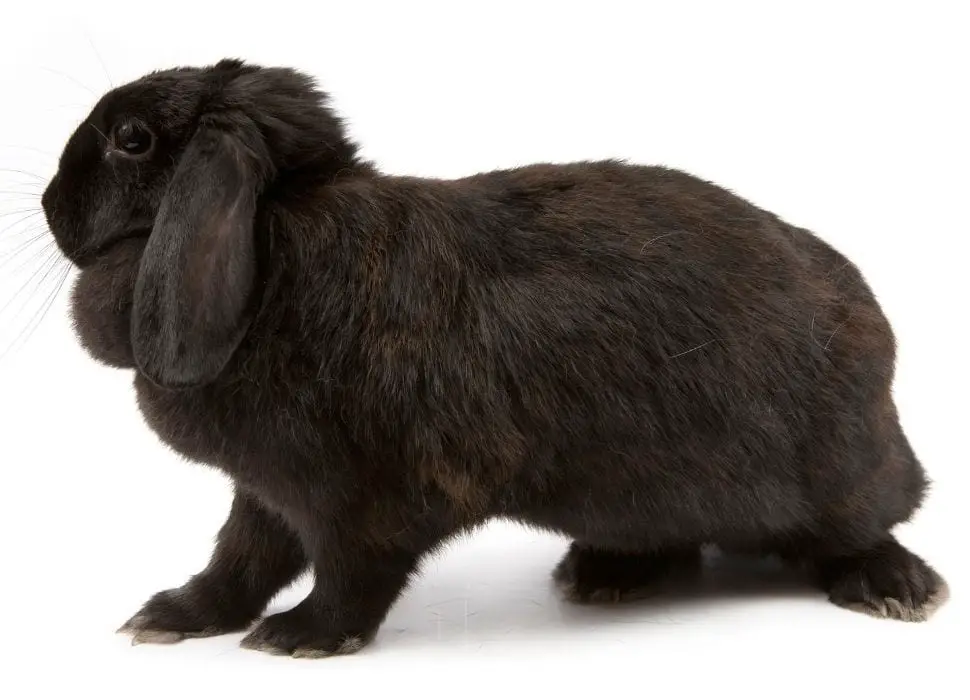If you’ve owned a rabbit for a while but just recently you’ve noticed that it’s not looking its usual pristine self or your clothing is picking up more rabbit hair than usual, rest assured you’re not alone. The usual explanation is that the rabbit is molting but what exactly is molting?
Molting is a term used to describe the period when rabbits (and other mammals) shed their winter coats. Rabbits can’t cool down through sweating or panting like other mammals but shedding excess fur as a warmer season approaches helps them to cope with the heat.
That’s the short answer and you’re probably relieved to know that molting is perfectly normal but let’s talk about this subject a bit more. As a rabbit owner, there are certain things you should be aware of when your rabbit is shedding its coat, some of which can be life-threatening!
Why do rabbits molt a lot?
Domesticated rabbits are born hairless but after a few days without fur, newborns will start to develop their first undercoat. After weaning at between 4 and 6 weeks of age this baby fur is replaced by a much more secure coat that stays in place until their first adult molting cycle starts at around 5 months of age.

Wild rabbits typically molt twice a year, once in the spring and once in the autumn, however, domestic rabbits kept indoors can experience a variety of different temperatures, and as such molting cycles will likely be every quarter (even more in some breeds). Naturally, if more consistent and comfortable indoor temperatures are maintained, molts can also be lighter and less noticeable.
For rabbits that live outdoors, seasons will of course be more of a factor affecting the frequency and weight of a molting. Rabbits kept outdoors in countries with colder climates and seasons will naturally grow a thicker winter coat in autumn before most of this is lost during the spring.
Bringing an outdoor rabbit into a warmer area than the pet is used to (a house) may even be enough to trigger a molt.
How long does rabbit molting last?
Generally molting lasts between two to three weeks, however, the duration of the molt will be dependent on the specific breed, longer-haired breeds such as Angoras may take a little longer.
What happens during molting?
The molting process itself usually begins from the head through the neck and back and goes all the way to the rump. Other rabbits will lose their fur in patches appearing all around their bodies at the same time and where new fur is growing.
New fur may appear darker in some shades of rabbit and this is perfectly normal. It’s often possible to see a line along the rabbit’s body separating two distinctly different shades, new fur and old.
Molting is a painless process for the rabbit in general but the rabbit’s skin may be slightly more sensitive to touch during the molt. For this reason, extra care should be taken when handling and brushing, some rabbits will be more averse to being touched and more likely to bite during a molting cycle.
How do I help a molting rabbit?
Brushing your rabbit often is the best way to give your rabbit an easy time through molting. Brushing speeds up the process and will improve a rabbits overall look (they can look quite unkempt during a molt). It will also allow you to have some control over where the fur is going rather than just having it all over the place.

If you want to give yourself and your pet an easy time during molting begin regular brushing from an early age (regardless of whether molting has started or not). This action will help build a trusting bond between you and the rabbit and by the time molting comes around the rabbit will already be used to being handled.
During a molt, you should brush a rabbit a couple of times a day. This may seem excessive, especially with shorter-haired breeds but even these will have a large amount of fur ‘undercoat’ which will need removing.
For those longer haired breeds of rabbit who will naturally shed their coats 3 – 4 times per year, extra care should be taken when brushing in case of knotted fur. This can catch and pull, potentially damaging the rabbits thin skin.
As touched on above, when a rabbit is going through a molt its skin may also feel more sensitive. In these cases, a rabbit may avoid letting you touch or pet it. Always take care when trying to handle a rabbit during a molt, they can act cranky and out of character. Coincidentally, I experienced this just this morning with my own molting rabbit – Princess, when I was bitten while trying to pet him (pictured below).

If this happens to you understand that your pet does not hate you! Behavior changes are normal in molting rabbits. Don’t be put off by aggression, shedding is a time when rabbits rely on us for a little help (even if they seemingly don’t appreciate it). A slight change in personality is normal and only temporary, the rabbit should return to its normal character after the molt is over.
Why is it important to brush/groom a rabbit during molting?
In the wild rabbits are groomed by other members of their colonies but domestic rabbits need us to help them.
It is expected that a small amount of fur will pass through a rabbit’s digestive system as a result of cleaning or grooming during a rabbit’s daily routine. You may notice this occasionally when you find droppings that appear to be joined together by something similar to a piece of string, this is rabbit hair that has been ingested.

During a molt, the amount of fur ingested can be significantly increased. This consequently increases the risk of hairball impactions in the rabbit’s digestive system. Brushing is important even during light molts to decrease the amount of fur the rabbit is likely to ingest and prevent gut stasis, a life-threatening condition common in rabbits (link to post ‘What is G.I Stasis’?).
How do I brush a rabbit during molting?
Brushing may be quite a stressful experience for rabbits particularly if their skin is tender. Before you start it’s a good idea to make the rabbit as comfortable as possible.
Start by laying down a towel or put a cushion on your lap for the rabbit to sit on while you brush.
When removing fur, only use wide-toothed combs and brushes with blunt ends, rabbits have very thin and delicate skin (this is quite visible if you look at the back of the neck) so avoid any comb with teeth that may scratch or injure the rabbit.
For longer breeds of rabbit, part the fur as you brush. Brushing needn’t be aggressive or hard, gentle brushing should be sufficient to remove fur that is ready to detach from the skin (never force the fur to come away unless it is ready).
For shorter breeds it is also possible to gently ‘pick’ the hair out of the rabbit, you should be able to identify hair that is ready to be removed as it will look scruffy compared to other areas of the coat. You will be amazed at how much hair you can collect doing this and once all the excess dead fur has been removed you can finish off by brushing the rabbit.
As an alternative to a brush, grooming gloves have now become popular among dog lovers and can work just as well with rabbits. The great thing about these is that the rabbit will not necessarily realize that it is being brushed.
How do I spot gastrointestinal stasis (G.I. Stasis) during molting?
When your rabbit is going through a molting cycle, pay careful attention to its droppings as these can be an indication of gut stasis.
A rabbit showing early signs may have droppings that appear to be small and dry which will then stop altogether. The rabbit may also be unwilling to move around freely or be seemingly not acting itself.
How do I prevent gut stasis?
Gut Stasis is a common but very serious condition in rabbits. Often the cause of many unexplained deaths, the nature of this condition along with the speed at which it can develop often means that it is sometimes not detected until its already too late.
From a rabbit owner’s point of view, the experience can be very upsetting. Seemingly healthy rabbits left for several hours can be found to be very sick just a few hours later.
Along with brushing during a molt, diet is very important in preventing gut stasis in rabbits. In particular, ensuring the rabbit has a high fiber diet. A high fiber diet along with keeping the rabbit hydrated is vitally important for their overall health and the prevention of gut stasis (and many other issues).
As well as fresh veggies, always ensure the rabbit has an unlimited amount of grass or hay available which will keep the digestive system working as it should. Here you can find a complete guide on exactly what you should be feeding your rabbit.
Allergies and rabbit fur
Rabbit fur can get everywhere during a molt, even if you brush twice a day. If the rabbit usually drinks from a water bowl ensure this is also free from fur to prevent the rabbit ingesting fur as it drinks.
Also, consider that rabbit fur (actually the saliva of the rabbit that is on the fur) can also cause an allergic reaction in some individuals. Brushing your rabbits regularly and vacuuming your house on a daily basis can help, but warn your visitors beforehand if you think it may be an issue.
Medical issue or just molting?
Lastly, while molting is perfectly normal be wary of medical concerns surrounding rabbit hair loss and learn to differentiate between these and normal molting.
Unusual losses of hair around the chin and the chest can sometimes be a result of dental problems, and heavy loss of fur around the hindquarters can indicate urinary tract issues and may be accompanied by urine burnt skin on the rabbit’s underbelly.
Rabbits generally deal with parasites such as lice by themselves however older rabbits may have some difficulty. Examine skin regularly for spots or flaky skin which may be a sign of lice and seek medical treatment if you are concerned about any of these issues.
Remember the molting process is over very quickly and although it’s a largely painless process, that doesn’t mean us owners shouldn’t lend a helping hand if necessary.
We hope this short article has answered some questions you may have had around molting and allow you to make the right decisions when dealing with your own rabbits.
Key things to remember during a rabbit molt
- Brush twice a day and avoid the need for constant vacuuming.
- Provide ample hay and water to minimize the risk of G.I. Stasis from hair impactions.
- Be gentle when handling or brushing as the rabbits skin may be tender.
- Use a blunt toothed comb or grooming glove to avoid damaging the rabbits delicate skin.
- Consider guests with allergies if you want to keep your friends!
- Ensure water bowls are free of stray fur, no one (including rabbits) likes a hair in their drink.
- Keep an eye out for signs of health issues and see a vet immediately if you are worried. Rabbits can decline very quickly when sick.
Sources
Further Reading
Molting Patterns: Normal and Abnormal vetstream.com
Fur Loss and Skin Problems in Domestic Rabbits bio.miami.edu
Rabbit Grooming petplan.co.uk
